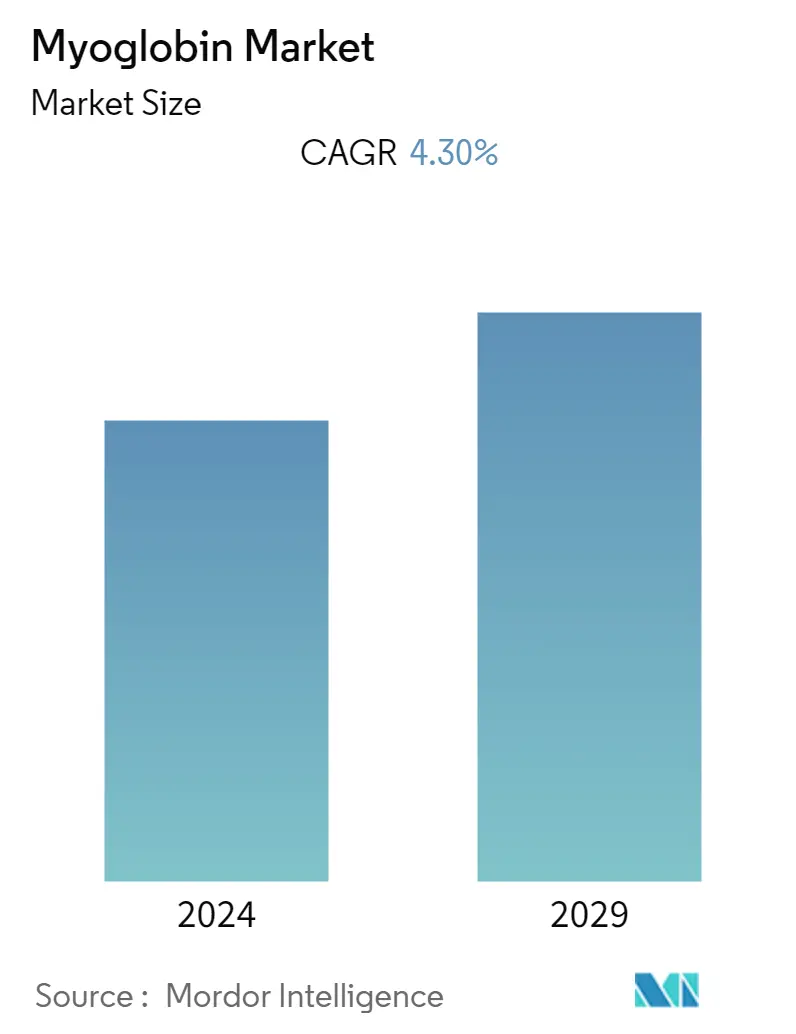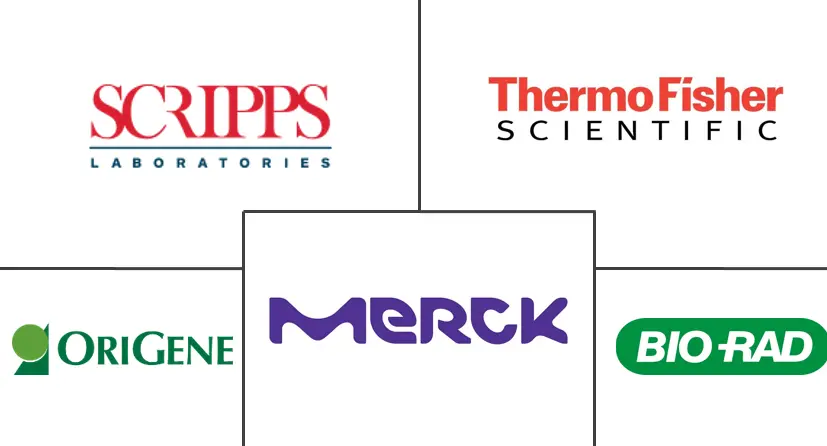Market Size of Myoglobin Industry

| Study Period | 2019 - 2029 |
| Base Year For Estimation | 2023 |
| CAGR | 4.30 % |
| Fastest Growing Market | Asia-Pacific |
| Largest Market | North America |
| Market Concentration | Medium |
Major Players
*Disclaimer: Major Players sorted in no particular order |
Myoglobin Market Analysis
The myoglobin market is expected to grow at a registered CAGR of 4.3% during the forecast period.
The COVID-19 Pandemic had impacted the global myoglobin market. Patients with COVID-19 have high levels of myoglobin supply to cells in muscles, and myoglobin has better prognostic performance than other cardiac markers in COVID-19. Besides, myoglobin is not only an important marker of myocardial injury, but it indicates systemic muscle damage. Hence, it was largely used during COVID-19 pandemic. For instance, according to the study published in the Frontier in Cardiovascular Medicine in November 2021, individuals with severe COVID-19 exhibited higher myoglobin (mb) levels than non-COVID-19 patients. Elevated mb levels and COVID-19 were associated with a significantly increased risk of death and severe illness. Thus, myoglobin was used during pandemic which resulted in the significant market growth.
The growing prevalence of cardiovascular diseases is the major factor that is driving the growth of the market studied. For instance, as per the American College of Cardiology Foundation data published in 2022, the prevalence of valvular heart diseases (VHD) is rising in the United States, with more than 5 million Americans diagnosed each year, while up to 1.5 million people suffer from aortic stenosis (AS) in the United States. Approximately 500,000 of these patients suffer from severe AS. A timely diagnosis of heart conditions allows clinicians to analyze the risk of their patients and prescribe relevant treatment. Hence, it is likely to increase the demand for myoglobin, thereby boosting the market's growth.
According to the study published in PubMed in August 2022, myoglobin is present in skeletal and cardiac muscle tissue. Myoglobin can be found in the blood 1 hour after myocardial damage, peaks between 4 and 12 hours later, and then promptly returns to baseline levels due to its low molecular weight. Thus, given its significance in the diagnosis of myocardial infarction, the demand for myoglobin is expected to increase over the forecast period.
However, a lack of awareness about myoglobin is expected to restrain market growth over the forecast period.
Myoglobin Industry Segmentation
As per the scope of the report, Myoglobin (Mb) is a cytoplasmic hemoprotein that binds and stores oxygen in cardiac myocytes and oxidative skeletal muscle fibers when there is insufficient delivery of blood oxygen. Myoglobin is a potential biomarker detected in the blood and serves as indices for physiological and pathological assessment in the diagnosis of various cardiological disorders. The Myoglobin Market is segmented by Product (Human Myoglobin and Animal Myoglobin), End User (Hospitals, Diagnostic Laboratories, and Research and Academic Institutes), and Geography (North America, Europe, Asia-Pacific, Middle East and Africa, and South America). The report offers the value (in USD million) for the above segments.
| By Product | |
| Human Myoglobin | |
| Animal Myoglobin |
| By End-User | |
| Hospitals | |
| Diagnostic Laboratories | |
| Research and Academic Institutes |
| Geography | ||||||||
| ||||||||
| ||||||||
| ||||||||
| ||||||||
|
Myoglobin Market Size Summary
The myoglobin market is poised for growth, driven by its critical role in diagnosing cardiovascular diseases and its increased utilization during the COVID-19 pandemic. Myoglobin serves as a vital marker for myocardial injury and systemic muscle damage, which was particularly relevant during the pandemic when elevated levels were associated with severe illness and increased mortality. The rising prevalence of cardiovascular conditions, such as valvular heart diseases and aortic stenosis, further fuels the demand for myoglobin, as timely diagnosis is essential for effective treatment. Despite its importance, a lack of awareness about myoglobin may hinder market expansion. The growing need for diagnostic laboratories, which are integral to healthcare systems, also supports market growth by facilitating accurate and efficient disease diagnosis.
Regionally, North America holds a significant share of the myoglobin market, bolstered by a robust biotechnology industry and substantial investments in cardiac biomarker research and development. The increasing incidence of cardiovascular diseases in the region underscores the demand for myoglobin tests. The market is characterized by fragmentation, with numerous regional and global players employing strategies like partnerships and acquisitions to expand their reach. Companies such as Bio-Rad Laboratories, Merck KGaA, and Thermo Fisher Scientific are key players in this space. Additionally, innovations like precision fermentation for plant-based myoglobin production, as seen with Ergo Bioscience, highlight ongoing advancements and diversification within the market.
Myoglobin Market Size - Table of Contents
-
1. MARKET DYNAMICS
-
1.1 Market Overview
-
1.2 Market Drivers
-
1.2.1 Increasing Prevalence of Cardiovascular Diseases
-
1.2.2 Growing Funding From Public and Private Organizations for R&D
-
-
1.3 Market Restraints
-
1.3.1 Lack of Awareness about Myoglobin
-
-
1.4 Porter's Five Force Analysis
-
1.4.1 Threat of New Entrants
-
1.4.2 Bargaining Power of Buyers/Consumers
-
1.4.3 Bargaining Power of Suppliers
-
1.4.4 Threat of Substitute Products
-
1.4.5 Intensity of Competitive Rivalry
-
-
-
2. MARKET SEGMENTATION
-
2.1 By Product
-
2.1.1 Human Myoglobin
-
2.1.2 Animal Myoglobin
-
-
2.2 By End-User
-
2.2.1 Hospitals
-
2.2.2 Diagnostic Laboratories
-
2.2.3 Research and Academic Institutes
-
-
2.3 Geography
-
2.3.1 North America
-
2.3.1.1 United States
-
2.3.1.2 Canada
-
2.3.1.3 Mexico
-
-
2.3.2 Europe
-
2.3.2.1 Germany
-
2.3.2.2 United Kingdom
-
2.3.2.3 France
-
2.3.2.4 Italy
-
2.3.2.5 Spain
-
2.3.2.6 Rest of Europe
-
-
2.3.3 Asia-Pacific
-
2.3.3.1 China
-
2.3.3.2 Japan
-
2.3.3.3 India
-
2.3.3.4 Australia
-
2.3.3.5 South Korea
-
2.3.3.6 Rest of Asia-Pacific
-
-
2.3.4 Middle East and Africa
-
2.3.4.1 GCC
-
2.3.4.2 South Africa
-
2.3.4.3 Rest of Middle East and Africa
-
-
2.3.5 South America
-
2.3.5.1 Brazil
-
2.3.5.2 Argentina
-
2.3.5.3 Rest of South America
-
-
-
Myoglobin Market Size FAQs
What is the current Myoglobin Market size?
The Myoglobin Market is projected to register a CAGR of 4.30% during the forecast period (2024-2029)
Who are the key players in Myoglobin Market?
Bio-Rad Laboratories, Inc., Merck KGaA, OriGene Technologies, Inc., Scripps Laboratories and Thermo Fisher Scientific are the major companies operating in the Myoglobin Market.

